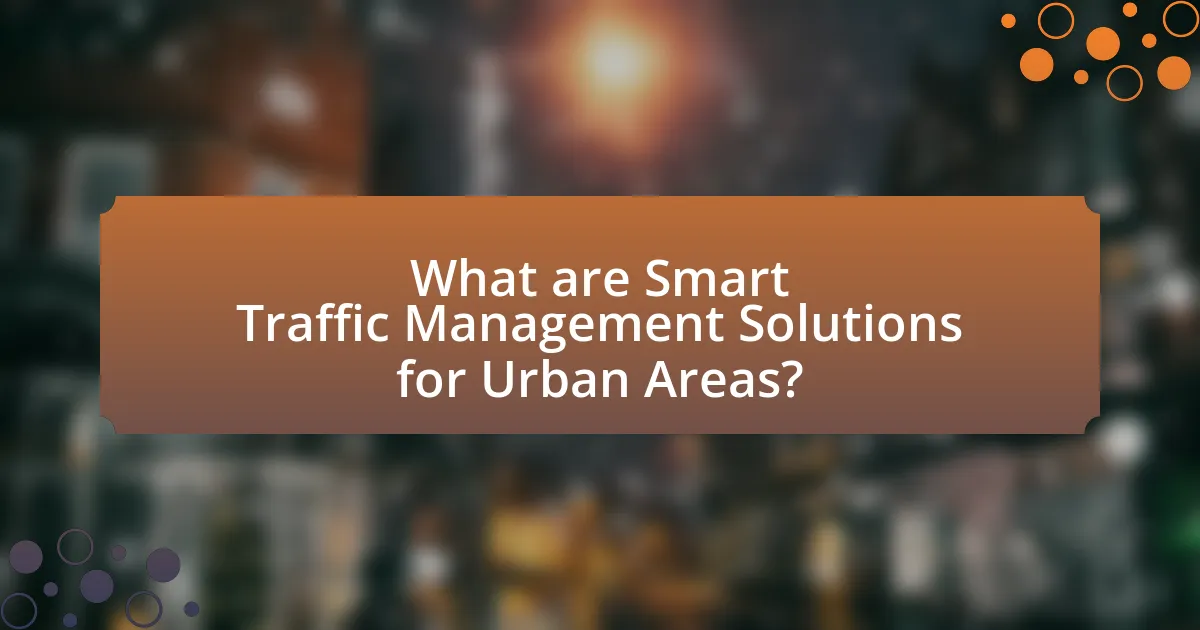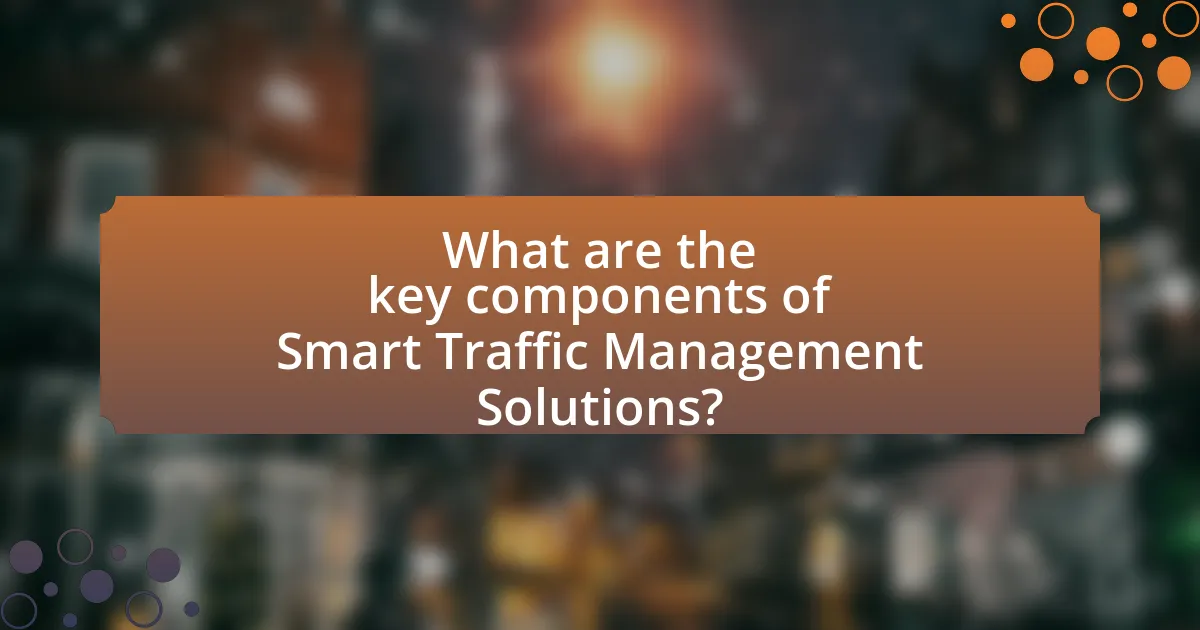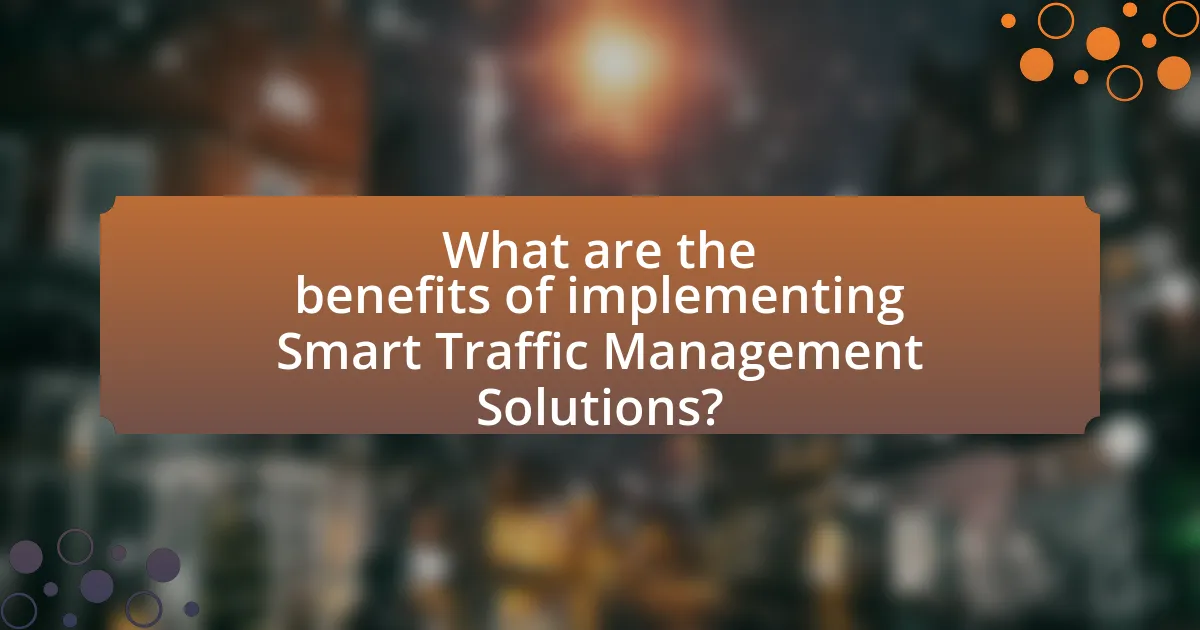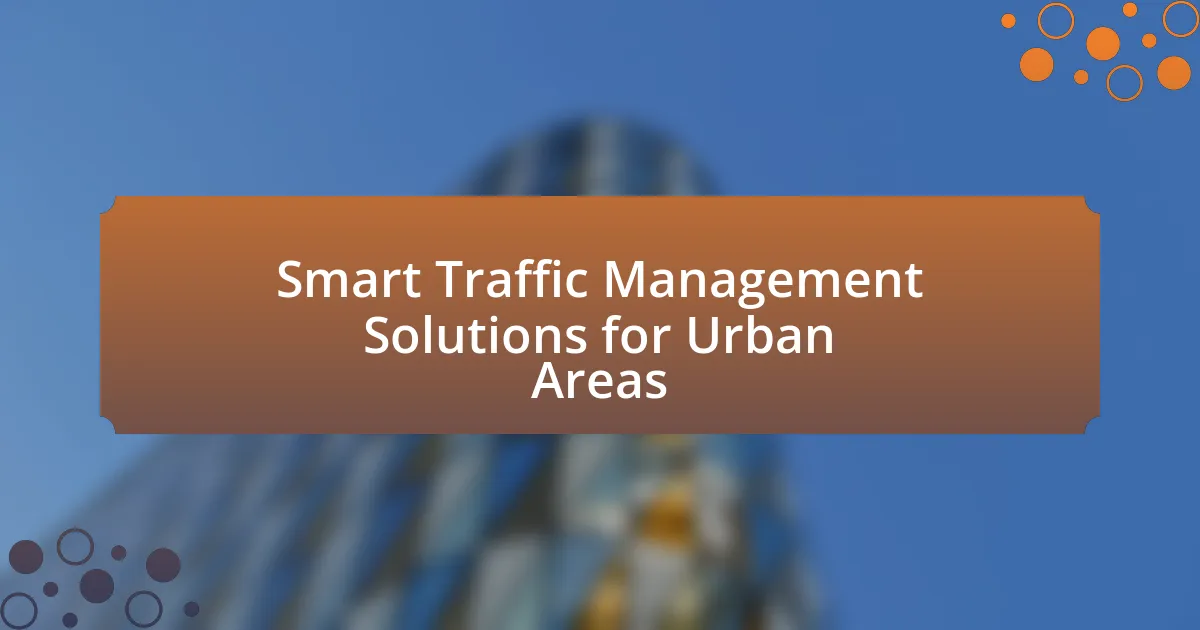Smart Traffic Management Solutions for Urban Areas are advanced systems designed to optimize traffic flow, reduce congestion, and enhance safety through the use of technology. These solutions leverage real-time data analytics, adaptive traffic signals, and integrated transportation systems to improve vehicle and pedestrian movement. Key technologies include IoT sensors, artificial intelligence, and advanced traffic signal control systems, which collectively enhance urban mobility and reduce travel times by up to 30%. The article also addresses the challenges urban areas face, such as traffic congestion and pollution, and highlights the economic advantages and best practices for implementing these solutions effectively.

What are Smart Traffic Management Solutions for Urban Areas?
Smart Traffic Management Solutions for Urban Areas are advanced systems that utilize technology to optimize traffic flow, reduce congestion, and enhance safety. These solutions often incorporate real-time data analytics, adaptive traffic signals, and integrated transportation systems to manage vehicle and pedestrian movement efficiently. For instance, cities like Los Angeles have implemented smart traffic signals that adjust their timing based on real-time traffic conditions, resulting in a reported 20% reduction in travel time. Additionally, the use of connected vehicle technology allows for better communication between vehicles and infrastructure, further improving traffic management.
How do Smart Traffic Management Solutions improve urban mobility?
Smart Traffic Management Solutions enhance urban mobility by optimizing traffic flow and reducing congestion. These systems utilize real-time data from sensors and cameras to adjust traffic signals, manage lane usage, and provide dynamic routing information to drivers. For instance, cities implementing adaptive traffic signal control can reduce travel times by up to 25% and decrease vehicle emissions by 10-20%, as evidenced by studies conducted in cities like Los Angeles and Singapore. By improving the efficiency of road networks, these solutions facilitate smoother transportation, ultimately leading to better urban mobility.
What technologies are utilized in Smart Traffic Management Solutions?
Smart Traffic Management Solutions utilize technologies such as IoT sensors, artificial intelligence, machine learning, and advanced traffic signal control systems. IoT sensors collect real-time data on traffic flow, vehicle counts, and environmental conditions, enabling dynamic adjustments to traffic signals. Artificial intelligence and machine learning analyze this data to predict traffic patterns and optimize signal timings, improving overall traffic efficiency. Advanced traffic signal control systems implement these optimizations, reducing congestion and enhancing safety. These technologies collectively contribute to smarter, more efficient urban traffic management.
How do these technologies interact with existing traffic systems?
Smart traffic management technologies interact with existing traffic systems by integrating real-time data analytics, adaptive signal control, and vehicle-to-infrastructure communication. These technologies enhance traffic flow and reduce congestion by optimizing traffic signal timings based on current conditions, which has been shown to decrease travel times by up to 20% in urban environments. For instance, systems like adaptive traffic signals utilize sensors and algorithms to adjust signal phases dynamically, responding to actual traffic volumes rather than fixed schedules. This integration not only improves efficiency but also supports the implementation of smart city initiatives, as evidenced by cities like Los Angeles, where such technologies have led to a significant reduction in travel delays and emissions.
What challenges do urban areas face that Smart Traffic Management Solutions address?
Urban areas face significant challenges such as traffic congestion, inefficient traffic flow, and increased pollution, which Smart Traffic Management Solutions effectively address. These solutions utilize real-time data analytics and adaptive signal control technologies to optimize traffic patterns, reducing delays and improving overall mobility. For instance, studies indicate that cities implementing smart traffic systems can experience a reduction in travel time by up to 20% and a decrease in vehicle emissions by approximately 15%, demonstrating the tangible benefits of these technologies in mitigating urban traffic issues.
How do traffic congestion and delays impact urban life?
Traffic congestion and delays significantly disrupt urban life by increasing travel time, reducing productivity, and contributing to environmental pollution. Urban residents often experience longer commutes, which can lead to stress and decreased quality of life. According to the Texas A&M Transportation Institute’s 2021 Urban Mobility Report, congestion costs U.S. drivers approximately $166 billion annually in wasted time and fuel. Additionally, traffic delays contribute to higher levels of air pollution, as idling vehicles emit more greenhouse gases. This combination of factors negatively affects public health, economic efficiency, and overall urban livability.
What role does pollution play in urban traffic management?
Pollution significantly influences urban traffic management by necessitating the implementation of strategies aimed at reducing emissions and improving air quality. Urban planners and traffic managers utilize pollution data to optimize traffic flow, implement congestion pricing, and promote public transportation, thereby minimizing vehicle emissions. For instance, cities like London and Singapore have adopted congestion charging schemes that directly link traffic management to pollution reduction efforts, resulting in decreased traffic volumes and improved air quality. These measures are supported by studies indicating that reducing traffic congestion can lead to a 30% decrease in vehicle emissions, highlighting the critical role pollution plays in shaping urban traffic management policies.

What are the key components of Smart Traffic Management Solutions?
The key components of Smart Traffic Management Solutions include advanced traffic signal control systems, real-time traffic monitoring, data analytics, and integrated communication networks. Advanced traffic signal control systems utilize algorithms to optimize traffic flow based on real-time conditions, reducing congestion and improving travel times. Real-time traffic monitoring employs sensors and cameras to gather data on vehicle counts, speeds, and congestion levels, enabling timely responses to traffic conditions. Data analytics processes this information to identify patterns and predict traffic behavior, facilitating proactive management strategies. Integrated communication networks connect various components, allowing for seamless information sharing among traffic management centers, vehicles, and infrastructure, enhancing overall system efficiency.
What types of data are collected for traffic management?
Traffic management systems collect various types of data, including vehicle counts, speed measurements, traffic flow rates, and incident reports. Vehicle counts provide insights into the number of vehicles on specific roadways, while speed measurements help assess compliance with speed limits and identify congestion. Traffic flow rates indicate how efficiently vehicles move through intersections and road segments, and incident reports document accidents or road obstructions that impact traffic conditions. These data types are essential for optimizing traffic signal timings, improving road safety, and enhancing overall traffic management strategies in urban areas.
How is real-time data used to optimize traffic flow?
Real-time data is utilized to optimize traffic flow by enabling dynamic traffic signal adjustments based on current conditions. Traffic management systems analyze data from sensors, cameras, and GPS devices to monitor vehicle density and speed, allowing for immediate changes to signal timings and routing. For instance, studies have shown that cities implementing adaptive traffic signal control can reduce congestion by up to 30%, as these systems respond to real-time traffic patterns rather than relying on fixed schedules. This data-driven approach enhances overall traffic efficiency and reduces travel times for commuters.
What are the sources of data for traffic management systems?
Traffic management systems utilize various data sources, including traffic sensors, GPS data, cameras, and social media feeds. Traffic sensors, such as inductive loop sensors and radar, provide real-time information on vehicle counts and speeds. GPS data from navigation apps like Google Maps and Waze offers insights into traffic flow and congestion patterns. Cameras equipped with image processing technology monitor traffic conditions and detect incidents. Additionally, social media platforms can provide crowd-sourced information about road conditions and accidents, enhancing situational awareness. These diverse data sources collectively enable effective traffic management and optimization in urban areas.
How do Smart Traffic Management Solutions integrate with other urban systems?
Smart Traffic Management Solutions integrate with other urban systems through data sharing and interoperability, enabling real-time communication between traffic signals, public transportation, and emergency services. These systems utilize sensors and IoT technology to collect traffic data, which is then analyzed to optimize traffic flow and reduce congestion. For instance, traffic signals can adjust their timing based on real-time traffic conditions, while public transport systems can receive updates to improve scheduling and efficiency. This integration enhances overall urban mobility and safety, as evidenced by cities like Barcelona, where smart traffic systems have led to a 20% reduction in travel time and improved emergency response times by 30%.
What is the relationship between traffic management and public transportation?
Traffic management and public transportation are interdependent systems that work together to enhance urban mobility. Effective traffic management optimizes the flow of vehicles and pedestrians, which directly impacts the efficiency and reliability of public transportation services. For instance, synchronized traffic signals can reduce delays for buses, improving their punctuality and attractiveness to commuters. Studies have shown that cities implementing smart traffic management solutions, such as real-time traffic monitoring and adaptive signal control, experience a significant increase in public transport usage, as these measures lead to reduced travel times and increased service frequency. This relationship underscores the importance of integrated planning and coordination between traffic management authorities and public transportation agencies to create a seamless urban transit experience.
How do Smart Traffic Management Solutions enhance pedestrian safety?
Smart Traffic Management Solutions enhance pedestrian safety by utilizing real-time data and advanced technologies to optimize traffic flow and reduce vehicle speeds in pedestrian-heavy areas. These systems employ sensors and cameras to monitor traffic patterns, allowing for adaptive signal control that prioritizes pedestrian crossings during peak times. For instance, studies have shown that cities implementing smart traffic signals have experienced a reduction in pedestrian accidents by up to 30%. Additionally, these solutions can provide alerts to drivers about nearby pedestrians, further increasing awareness and safety.

What are the benefits of implementing Smart Traffic Management Solutions?
Implementing Smart Traffic Management Solutions significantly enhances urban mobility and reduces congestion. These systems utilize real-time data analytics and adaptive signal control to optimize traffic flow, which can lead to a reduction in travel time by up to 30% in some cities. Additionally, they improve safety by decreasing the likelihood of accidents through better traffic monitoring and management. Studies have shown that cities employing smart traffic solutions experience a decrease in emissions, contributing to improved air quality. For instance, a report by the U.S. Department of Transportation indicated that smart traffic systems can reduce vehicle emissions by 10-20%. Overall, these solutions lead to more efficient transportation networks, benefiting both commuters and the environment.
How do these solutions contribute to reducing traffic congestion?
Smart traffic management solutions contribute to reducing traffic congestion by optimizing traffic flow through real-time data analysis and adaptive signal control. These systems utilize sensors and algorithms to monitor traffic conditions, allowing for dynamic adjustments to traffic signals based on current demand. For instance, studies have shown that cities implementing adaptive traffic signal systems can reduce delays by up to 30% and improve overall traffic throughput. Additionally, these solutions often integrate with navigation apps to provide drivers with real-time information about congestion, encouraging alternative routes and reducing the number of vehicles on heavily trafficked roads.
What impact do Smart Traffic Management Solutions have on travel times?
Smart Traffic Management Solutions significantly reduce travel times by optimizing traffic flow and minimizing congestion. These systems utilize real-time data analytics, adaptive signal control, and integrated communication technologies to manage traffic more efficiently. For instance, studies have shown that cities implementing smart traffic systems can experience travel time reductions of up to 20-30%. This improvement is attributed to better traffic signal timing, reduced stop-and-go conditions, and enhanced route guidance for drivers, leading to smoother traffic movement and decreased delays.
How do they improve overall road safety?
Smart traffic management solutions improve overall road safety by utilizing real-time data and advanced technologies to optimize traffic flow and reduce congestion. These systems employ sensors, cameras, and artificial intelligence to monitor traffic conditions, allowing for timely adjustments to traffic signals and the implementation of dynamic routing. For instance, studies have shown that cities implementing smart traffic systems have experienced a reduction in traffic accidents by up to 30%, as these solutions help prevent collisions through better traffic control and enhanced communication with drivers.
What economic advantages do Smart Traffic Management Solutions provide?
Smart Traffic Management Solutions provide significant economic advantages by reducing congestion, lowering operational costs, and enhancing productivity. These systems optimize traffic flow through real-time data analysis and adaptive signal control, which can lead to a reduction in travel time by up to 30%, as evidenced by studies conducted in cities like Los Angeles and Singapore. Additionally, decreased congestion results in lower fuel consumption and emissions, translating to cost savings for both commuters and municipalities. For instance, a report from the Texas A&M Transportation Institute indicates that congestion costs the U.S. economy over $166 billion annually, highlighting the potential economic benefits of implementing smart traffic systems to alleviate these costs.
How can cities save costs through efficient traffic management?
Cities can save costs through efficient traffic management by optimizing traffic flow, reducing congestion, and minimizing delays. Implementing smart traffic signals and real-time traffic monitoring systems can lead to a 20-30% reduction in travel times, which directly translates to lower fuel consumption and decreased vehicle operating costs. Additionally, studies show that effective traffic management can reduce the need for road expansions and maintenance, saving municipalities significant funds. For instance, the Texas A&M Transportation Institute reported that congestion costs U.S. drivers approximately $166 billion annually, highlighting the financial benefits of improved traffic management strategies.
What are the long-term financial benefits for urban areas?
The long-term financial benefits for urban areas include reduced congestion costs, increased property values, and enhanced economic productivity. Smart traffic management solutions can significantly decrease travel times and fuel consumption, leading to an estimated annual savings of $166 billion in the U.S. alone due to reduced congestion, as reported by the Texas A&M Transportation Institute. Additionally, improved traffic flow can raise property values by up to 20% in well-managed areas, as efficient transportation systems attract businesses and residents. Furthermore, cities implementing smart traffic solutions often experience a boost in economic activity, with studies indicating that every dollar invested in public transportation generates approximately $4 in economic returns.
What best practices should cities follow when implementing Smart Traffic Management Solutions?
Cities should prioritize data integration and real-time analytics when implementing Smart Traffic Management Solutions. This approach enables the collection and analysis of traffic data from various sources, such as sensors and cameras, to optimize traffic flow and reduce congestion. For instance, cities like Los Angeles have successfully utilized real-time data to adjust traffic signals dynamically, resulting in a reported 12% reduction in travel times. Additionally, engaging stakeholders, including local communities and transportation agencies, ensures that the solutions meet the needs of all users. Implementing adaptive traffic signal control systems can further enhance efficiency, as evidenced by studies showing that such systems can improve traffic flow by up to 30%. Lastly, continuous monitoring and evaluation of the implemented solutions are crucial for making necessary adjustments and improvements over time.
